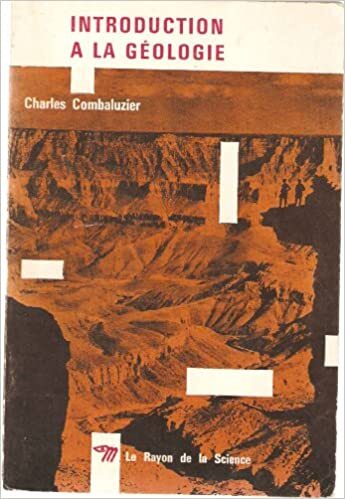Introduction à la Géologie
A relatively brief and good introduction to geology in French.
Geological time
This book stresses the notion and awareness of geological time and its immense relative size in comparison with our own lives and even all of human history.
An example of the geological processes in time and their rate is given: the rrosion of the Alps:
Mechanical an chemical erosion make the Alps loose 0.57mm of height every year on average. That is 1m in 17 000 years, or 1km in 17 million years. At this rate the Alps will be reduced to planes in 60 million years.
Geology
The book elegantly sums up a definition of geology as:
la histoire de la Terre et de la Vie jusqu’à l’homme.
The history of the Earth and of Life before Man.
History of the World
Through petrology (lithology) and mineralogy one seeks to understand the nature of the matter in the Earth’s crust.
Through stratigraphy one seeks to uncover the secrets (literally) buried in the various deposited sediments around the world. These are important because the sediments preserve remains of earlier versions of Life.
Tectonics is the study of the structure and movements of the masses in the Earth’s crust.
History of Life
Because of the fact that pretty much any sediment on Earth contains fossils, they permit the study of earlier lifeforms through the remains found there. The layering of the deposited sediments over time and the different fossils therein contained give us an idea of the period and era that the lifeforms belong to.
Importantly, the layering also shows the development of evolutionary solutions and their changes.
Paleontology is the study of early life through fossils preserved in sediments
The structure of the Earth
The Earth is a more or less spherical body of $\approx6400km$. The main layering of the Earth is as follows:
- Core: $3370km$
- Mantle: $3000km$, silicates (Si, O)
- Pyrosphere: $2940km$, silicates + Al
- Lithosphere: $60km$, silicates + Mg
- Crust
Together with the lithosphere, the hydrosphere and the atmosphere form the basis for the biosphere, in which we all live.
Wegener (1912) proposed that the continents move around on the Earth’s surface, so called continental drift. His hypothesis was confirmed in the 1950s after having been rejected since its conception.
Rocks and minerals
Three different types:
- sedimentary
- metamorphic
- volcanic
Processes that has turned sediments into metamorphic types of rock impede us to know more about the very early stages of developments in the Earth’s history.
Erosion
Processes on the Earth’s surface constantly act on the matter present, thus changing it irriversibly. The effects of these forces and the breakdown caused by it is called erosion.
Physical erosion
- Glaciers
- Oceans
- Temperature
- Wind
Chemical erosion
- Streams
- Rain
Eras of the Earth
- Anté-Primaire (l’Anté-Cambrien, Pré-Cambrien)
- Primarie
- Secondaire - Reptiles
- Tertiaire - Man appeared
- Quaternaire
Evolution
The book mentions that in animal societies like the ones formed by ants and termites, the individuals are
totally enslaved by their function.
Meaning that they are in a way locked-in by evolution and that certain changes on an individual level are hindered by the society at large. The point being that:
La moindre modification devient impossible sans compromettre la vie de l’ensable. Les societés d’insectes sont dans une impasse.
In the book this point leads the notion that Man is somehow different in its ability to adapt. This due to its brain and neural system.
Extracts
-
Nous comptons notre vie en années. C’est le retour cyclique des saisons qui rythme nos activités, nous avons un conge annuel, des fêtes, des anniversaires annuels. toute notre vie est scandée par ce périple de la Terre autor du Soleil. Il faut un longue et patiente culture historique, littéraire, artistique, pour que l’intellectuel arrive à penser en siècles. Pour qu’à l’appel d’un nombre soit evoquée, au moins dans ses grand lignes, une époque que nous n’avons pas vécue nous-mêmes, mais que nos ancêtres ont rempli de leur présence, de leur cris de joie, du fracas de leur querelles, des plaintes de leur souffrances.
p. 13
-
Au lieu qu’en géologie nous étudions des phénomènes d’une ampleur immense, qui se sont certainment déroulés, mais nous n’avons pour le moment aucun moyen, non seulment de conaître avec précision leur durée inhumaine, mais même de savoir exactement ce qui s’est passé.
p. 15
-
Il me semble que l’immense domaine de la géologie peut s’intituler: histoire de la Terre et de la Vie jusque’à l’homme.
p. 17
-
Bref, la Vie n’est pas représentée sur la Terre par des êtres juxtaposés, elle constitueune complexe vivant indissociable en liaison étroite avec la planète: la Biosphère.
p. 63
-
Pour le savant, la Vie est, en quelque sorte, une fonction de la Terre, la plus noble sans aucun doute, et le philosophe est en droit de se demander si la Vie n’est pas la raison d’être de la Terre.
p. 63
-
Nous arrivons ainsi au chiffre 3 760 000 000 d’années pour la phase sédimentaire de la Terre, c’est-à-dire pour l’âge probable de la Vie
p. 105
-
L’étude des espèces disparues au cours de ces millions de siècles nous révèle que l’expansion des êtres vivants es le fruit d’une prodigieuse lutte pour la vie, non seulement contre des antagonistes qui, plus faibles, furent vaincus, mais aussi contre l’hostilité du milieu, et nous connaissons maintenant la condition profonde de ces innombrabables victoires: l’adaption
p. 164
-
S’adapter ou périr, telle est la règle du jeu, du jeu tragique de la vie et de la mort; les êtres vivants se sont adaptés aux conditions les plus invraisemblables pour survivre et proliférer: telle est l’explication que nous fornit la paléontologie.
p. 164
Vocabulary
|
|
